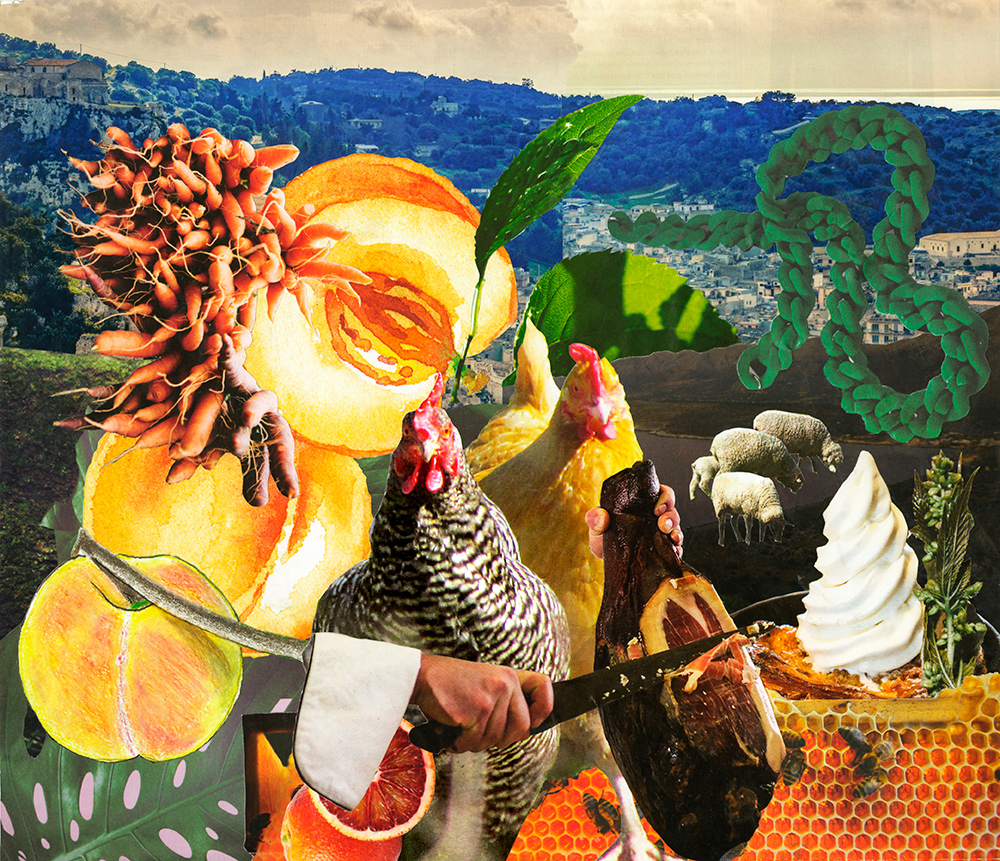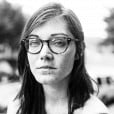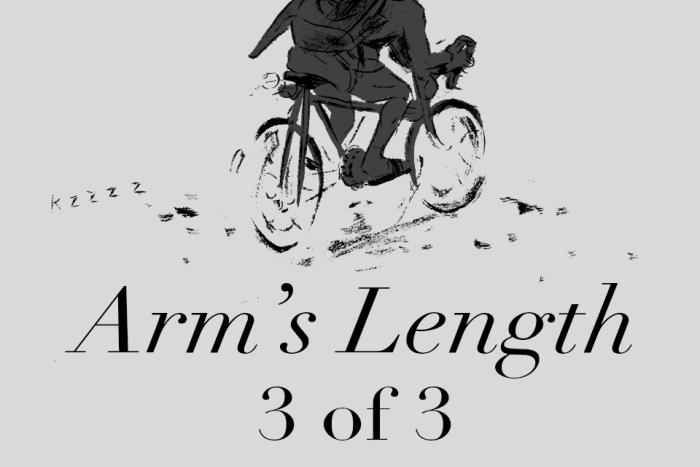
Mouthful is a new monthly column about the author’s relationship with food, ten years into recovery from anorexia and bulimia.
In one of my earliest memories, I’m riding in the backseat of my parents’ car on a family road trip. I’m three; it’s another year before my parents go vegetarian. As we pass a cattle ranch in Central Florida, I point to a docile-looking heifer and ask, “Can we kill that cow and eat it?”
I’d only recently learned about the animal origin of my most-loved food. Prior to my parents’ vegetarianism, one of my favorite things to eat was my father’s T-bone steak. He would grill it in our open garage, silhouetted against the early evening streetlights. The aroma would reach back through the plywood door to the kitchen, and I would wait with my mother at our modest wooden table—fork ready, and my side of green beans—and talk with her to distract myself from waiting for the main course. My dad knew I liked it rare. I would eat it with salt—only salt—in small pieces. It was blood red on the inside, the juices pooling around my plate.
*
We were practitioners of a marginal religion called Unity. A denomination of the New Thought movement, it’s something of a lovechild of Christian Science and Zen Buddhism. It was founded in 1889 by Charles Fillmore and his wife, Myrtle, when Myrtle attended a faith healing seminar and soon after claimed to have cured herself of tuberculosis. The central principle of Unity is that consciousness shapes material reality. Everything from ill health to world war can be chalked up to wrong thinking. Likewise, right thinking can bring about a state of harmony: good health, agape love, global peace—heaven on earth.
Until shortly before his death in 1948, Charles Fillmore also taught that, as with everything we consume, food shapes our consciousness. We “eat life, not matter,” and “Cruelty, war, and wanton destruction of human life will continue so long as men destroy animals.” My parents are pacifists. Violent speech and behavior were verboten in our house. But for them, vegetarianism was more than a nonviolent lifestyle: it was also a method of spiritual purification. They would not eat death.
After Charles Fillmore’s death, Unity leadership was passed along to his son and subsequently other members of the Fillmore family. With each passing of the reigns, the faith edged closer to the religious mainstream. Inclusiveness was a way of growing Unity’s reach in America—certain churches even promoted New Age and spiritualist practices such as crystal healing and “channeling,” or conversing with spirits. Yet, others grew concerned about what they perceived to be the increasing vagueness of the Unity religion.
In 1989, the Unity centennial, my father co-founded a fundamentalist council to realign Unity with the vision of its creators. As a symbol of their faith, my parents adopted the Fillmores’ diet. No longer would they eat “anything with a face,” they said to friends and waiters alike. The purification even extended from the food they ate into the way we talked about food in general: No longer was my mother’s soup to die for—it was now “life giving.”
*
It is New Thought philosophy not to adhere to dogma but to seek truth continuously and omnivorously; each Unity student is on her own spiritual journey. My parents didn’t make me go vegetarian. I decided on my own six years later, when a kid in my class gave me a PETA pamphlet about slaughterhouses. I showed it to my parents that night at the kitchen table.
“I’m vegetarian now,” I announced.
My mother looked down at the baked chicken she’d served me. Even while abstaining, my parents were always happy to feed me meat if I asked for it. I had Lunchables in my lunchbox. I even had the occasional steak.
“What about this meal?” she asked.
I pondered my options, whether to toss the chicken or eat it.
Looking back on this now, I think of Charles Fillmore’s distinction between eating life and eating matter. The food on my plate was dead by his definition, but something in it, to my young mind, still contained life: If I threw it away, it would be wasted, but eating it would give me energy. The decision seemed matter-of-fact, but the choice was between life or death.
“It’s too late for this chicken,” I said.
*
Frequently over the years, people would ask me how I justified eating plants. It’s possible they were genuinely curious; it’s more likely that they were looking to get a rise out of me. Still, the question struck me as a good one. “You don’t kill the plant,” I’d tell them, implying that taking only part of the organism was acceptable. Of course, this ignored many realities of agriculture. The truth is, I still don’t have an answer. When I let myself contemplate the contradiction too deeply, I never reach the bottom. My feeling of personal purity chips away with simple logic. Not eating meat is good, but what about cheese? Leather? My animal-tested shampoo? What about the migrant child laborers who toil away for long hours in hot orchards to pick the peaches I insist on eating for breakfast?
When I was in high school, I went vegan for two weeks—then fell off the wagon because I was always hungry. I went vegan again as a senior in college, and that time managed to abstain from animal products for two years. Both times, I did it for purportedly political reasons—though, in retrospect, it’s interesting how quickly my political convictions flagged in the face of pressure. Once I returned to eating meat, I no longer read voraciously about the meat industry; no longer initiated conversations about big agriculture; no longer paused over animal cruelty-related articles in my Facebook feed. As long as I wasn’t engaging with my guilt, I could forget that what I was eating perpetuated violence.
The second time I went vegan, I was also bulimic. Bulimia quickly turned into anorexia as veganism removed some of my favorite binge foods and introduced the pleasurable feeling of eating less. My desire to live without violence aligned nicely with my desire to be thin—at least on the outside. Upon deeper examination, I have to admit that my real desire was more existential.
In Unity, death, like all material reality, is a manifestation of consciousness. Therefore, via our consciousness, we can also transcend death. Eating animals was in conflict with the goal of transcending death in being a symptom of “wrong consciousness,” which manifests error in the material world. “I don’t intend to die,” my father used to tell me. “I like this body. I’m going to keep it until I become the body of light,” referring to Unity’s version of the story of Jesus Christ. Like my father, I also tried to transcend death, tried to escape my body, tried to become light. The purification of my food was part of my overall quest for bodily purification. For immateriality.
My second period of veganism ended when I was twenty-four. I fell in love with a non-vegan, and he was less than understanding about us having to sometimes prepare separate meals. At the time, I was almost two years into recovery from anorexia and working as a line cook in a pizza restaurant, interacting daily with various alluring cheeses and cured meats. I fielded questions from my coworkers about how I managed to justify being vegan while serving pizzas, and whether I enjoyed the smell of sausage, and how much of a difference I really felt I was making as a lone vegan person. Drunk in love, frustrated by constant harassment, and discouraged by my inability to square the seeming hypocrisies of my veganism, I finally caved on a handful of ricotta.
*
I ate meat for the next five years. Then I wrote my first book, Binary Star, a semiautobiographical novel about an anorexic college student and her alcoholic boyfriend who go militantly vegan. My research led me deep into the factory farming industry. I saw the pain of my anorexia reflected in the suffering of caged animals. I felt the powerlessness of my disease magnified in my powerlessness as a consumer, complicit in the enslavement and torture of innocent life. Each time I walked down the dairy aisle at the supermarket, I recalled the images of infected and swollen udders, the pitiful cries of calves separated from their mothers, the blood on the slaughterhouse floor. The day I finished the manuscript, I called my husband and told him I was vegan.
But underwriting my commitment to boycott factory farming was a lingering, more selfish aspiration to approach a state of pure nonviolence by eliminating all traces of violence from the matter I consumed. Veganism was not merely a diet for me, I told myself, not even merely a lifestyle, but rather—like Charles Fillmore’s vegetarianism, like my parents’ vegetarianism—a spiritual mission. The violence of the factory farms was like an infection that could be transferred into me through my food, a kind of filth from which I sought to be cleansed. When I thought about it, though, everything I consumed was mitigated somehow by the violence of late capitalism: my leather-free shoes were made in a sweatshop; my animal-friendly toothpaste was delivered to the store on a truck burning fossil fuel; Monsanto manufactured my organic breakfast cereal. Nothing was sacred.
*
There are ways to become purer. I can make my own granola. If I have a yard, I can plant a garden. I can save up and buy my shoes from an ethical company.
But ethical consumerism encapsulates for me the conflict between accepting myself as I am and also endeavoring to be better. Each day, I strive to accept my limitations; I also work to overcome them. I’m aware of my flaws; I also see my own potential. I’m an animal who craves meat; I’m also a sentient being aware of other beings’ sentience. I can do my best to make conscious choices, but in the end, I’m just a consumer. I’m a body with cravings.
Meanwhile, my definition of “better” continues to shift. Today, I try to be healthier, kinder—but this wasn’t always the case. Or rather, my idea of what constitutes health once included, for example, a three-hundred-calorie-a-day diet. Being kinder has not always included being kinder to myself, even as it included being kind to animals. At times, being kind to animals has only applied to animals I knew personally. And being kind to myself has at different times meant eating an entire pint of ice cream or eating a kale salad.
*
I started eating meat again last year when my husband and I were driving across the country. Much of what we ate was procured in gas stations and mom-and-pop diners—traditionally vegan-unfriendly places. Meanwhile, I had recently started my second book, Sunshine State, and was myself in a porous state of open curiosity, which was leading me away from my studies of the ills of modern agriculture. In other words: I had again stopped engaging with them. There’s no political justification for the way I eat today. There’s not even an easy explanation for how I came to the decision to break with my veganism, in the moment. If I had to recite my thinking, it would go something like: “I’m writing a new book, so must be open to all experience.” Now that the book is finished, I’m revisiting my original thinking: whether starting another book should mean continuing to keep myself “open.” Whether that was a bullshit excuse from the start. Whether continuing to eat meat today constitutes a kind of laziness. Or whether it’s life-giving.
*
There’s no distinction between life and matter—the two are inextricable. Even as my father believed the steak he fed me was dead, he knew it would keep me alive. Matter consumes matter, so life feeds on life, until life ends. Each time I eat, I keep myself alive, and I’m also closer to death.
Last night, my husband prepared pork belly. Until this week, I had never had pork belly before. There are many meat dishes I’ve never had, as someone who has spent many years abstaining from meat. He used star anise, cardamom, apples, and fennel. I separated the skin from the fat from the meat and a story played out in the back of my mind in which the pig I was eating was born and suckled. It lived on a local farm with dozens of others. It was sent to a processing plant where it was hung up, bled, butchered, and wrapped. Pieces of its body rode in trucks to supermarkets around the northeast. One of those pieces found its way into my kitchen. And here it was, and I was eating it. And it was delicious.
Collage by Sarah Gerard.





